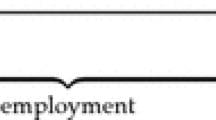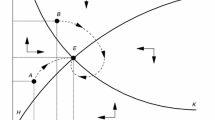Abstract
We have examined the effects of ageing on the balanced-growth-maximizing public investment policy in an overlapping generations model with growth engines of public capital accumulation. Extended life expectancy tends to increase individual savings, while the increased old-age dependency requires more resources to be allocated to consumption in the economy. Declining working population makes for a severe trade-off between private and public capital accumulation. It is shown that as ageing proceeds, not only the income tax rate must be raised to accelerate public capital formation but the expenditure share of maintenance should be increased in order to maximize the balanced-growth rate.
Similar content being viewed by others
References
Altonji, J. G., Hayashi, F., & Kotlikoff, L. (1992). Is the extended family altruistically linked? Direct tests using micro data. American Economic Review, 82, 1177–1198.
Aschauer, D. A. (1989). Is public expenditure productive?. Journal of Monetary Economics, 23, 177–200.
Barro, R. J. (1990). Government spending in a simple model of endogenous growth. Journal of Political Economy, 98, S103–S125.
Barro, R. J., & Sala-i-Martin, X. (1992). Public finance in models of economic growth. Review of Economic Studies, 59, 645–661.
Blackburn, K., & Cipriani, G. P. (2002). A model of longevity, fertility and growth. Journal of Economic Dynamics and Control, 26, 187–204.
Diamond, P. A. (1965). National debt in an neoclassical growth model. American Economic Review, 55, 1126–1150.
Eckstein, Z., & Wolpin, K. I. (1985). Endogenous fertility and optimal population size. Journal of Public Economics, 27, 93–106.
Evans, P., & Karras, G. (1994). Is government capital productive? Evidence from a panel of seven countries. Journal of Macroeconomics, 16, 271–279.
Futagami, K., Morita, Y., & Shibata, A. (1993). Dynamic analysis of an endogenous growth model with public capital. Scandinavian Journal of Economics, 95, 607–625.
Glomm, G., & Ravikumar, B. (1994). Public investment in infrastructure in a simple growth model. Journal of Economic Dynamics and Control, 18, 1173–1187.
Glomm, G., & Ravikumar, B. (1997). Productive government expenditures and long-run growth. Journal of Economic Dynamics and Control, 21, 183–204.
Greiner, A., & Semmler, W. (2000). Endogenous growth, government debt and budgetary regimes. Journal of Macroeconomics, 22, 363–384.
Hayashi, F. (1995). Is the Japanese extended family altruistically linked? A test based on Engel curves. Journal of Political Economy, 103, 661–674.
Holtz-Eakin, D. E. (1994). Public sector capital and the productivity puzzle. Review of Economic Statistics, 76, 12–21.
Iwamoto, Y. (1990). An evaluation of public investment policy in postwar Japan. Economic Review, 41, 250–261 (in Japanese).
Kalaitzidakis, P., & Kalyvitis, S. (2004). On the macroeconomic implications of maintenance in public capital. Journal of Public Economics, 88, 695–712.
Kato, R. R. (2002). Government deficit, public investment, and public capital in the transition to an aging Japan. Journal of Japanese and International Economies, 16, 462–491.
Laitner, J., & Ohlsson, H. (2001). Bequest motives: a comparison of Sweden and the United States. Journal of Public Economics, 79, 205–236.
Rioja, F. (2003). Filling potholes: macroeconomic effects of maintenance versus new investment in public infrastructure. Journal of Public Economics, 87, 2281–2304.
Turnovsky, S. J. (1997). Fiscal policy in a growing economy with public capital. Macroeconomic Dynamics, 1, 615–639.
Yakita, A. (2001). Uncertain lifetime, fertility and social security. Journal of Population Economics, 14, 635–640.
Yakita, A. (2004). Elasticity of substitution in public capital formation and economic growth. Journal of Macroeconomics, 26, 391–408.
Zhang, J., Zhang, J., & Lee, R. (2001). Mortality decline and long-run economic growth. Journal of Public Economics, 80, 485–507.
Author information
Authors and Affiliations
Corresponding author
Rights and permissions
About this article
Cite this article
Yakita, A. Ageing and public capital accumulation. Int Tax Public Finance 15, 582–598 (2008). https://doi.org/10.1007/s10797-007-9041-0
Published:
Issue Date:
DOI: https://doi.org/10.1007/s10797-007-9041-0




